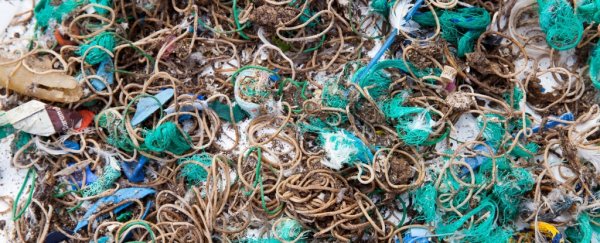No humans live on Mullion Island off the coast of Cornwall in Britain. No humans are even allowed to set foot on the remote island without a permit. Mullion Island is a protected sanctuary for seabirds - and yet conservationists kept finding rubber bands there - in the thousands.
Now, rangers think they have figured out the culprit. It's the birds themselves, great black-backed gulls (Larus marinus) and herring gulls (Larus argentatus), looking for food on the mainland and mistaking the rubber bands for worms.
Great quantities of rubber bands were found in pellets, the masses of indigestible food such as bones and fur that some birds regurgitate after a meal. Some seemed new, but many were older, and degraded, leading experts to believe the birds have been eating them for decades.
Experts believe the birds found the rubber bands on horticultural fields on the mainland, where they are used to tie bunches of flowers.
Although the rubber bands were the most prominent interloper, they weren't the only human trash found in the pellets. Lengths of string and fishing net were found too. The team even found one bird that had died after becoming entangled in a large fishing hook.
"We first noticed the bands on a monitoring visit during the breeding season and were puzzled why there were so many and how they'd got there," explained conservationist Mark Grantham from the West Cornwall Ringing Group.
"To save disturbing the nesting birds, we made a special trip over in the autumn to clear the litter. Within just an hour we'd collected thousands of bands and handfuls of fishing waste."
Seagulls are usually seen as something of an annoyance - they're rowdy, raucous, and love getting into human snacks. And, although European herring gull numbers have been rising in seaside towns, it's not indicative of broader trends.
Between 1969 and 2015, the British population of European herring gulls declined by 60 percent as a direct result of anthropogenic influences, including changes to fish food sources, and nesting site disturbances - which is likely at least part of the reason why they've started living in towns and stealing garbage.
Things aren't looking rosy for the great black-backed gull, either. In recent years, its breeding numbers have been very variable, and the most recent breeding season was very poor, Grantham said.
So they're already facing stressors from a number of directions; and "eating elastic bands and fishing waste does nothing to ease their plight," said area ranger Rachel Holder of the National Trust, which manages the island.
"Places like Mullion Island should be sanctuaries for our seabirds, so it's distressing to see them become victims of human activity."
Mullion Island is small, rocky and treeless. Only the birds and low vegetation live there, so it should have been a safe place for the birds to nest. But human garbage has found its way to far more remote locations - the icy wilderness of Antarctica, and the dark depths of the Mariana Trench.
And, as we have seen with whales, ingesting human garbage can be incredibly harmful to wildlife, resulting in starvation and death.
The National Trust is now requesting local businesses and residents reconsider how they dispose of their waste products, including plastic, latex and rubber.
"Single-use materials are having an alarming impact on our country's most remote places," said Lizzy Carlyle, Head of Environmental Practices at the National Trust.
"It's up to all of us to take responsibility for how we use and dispose of these items - whether we're producers or consumers."
